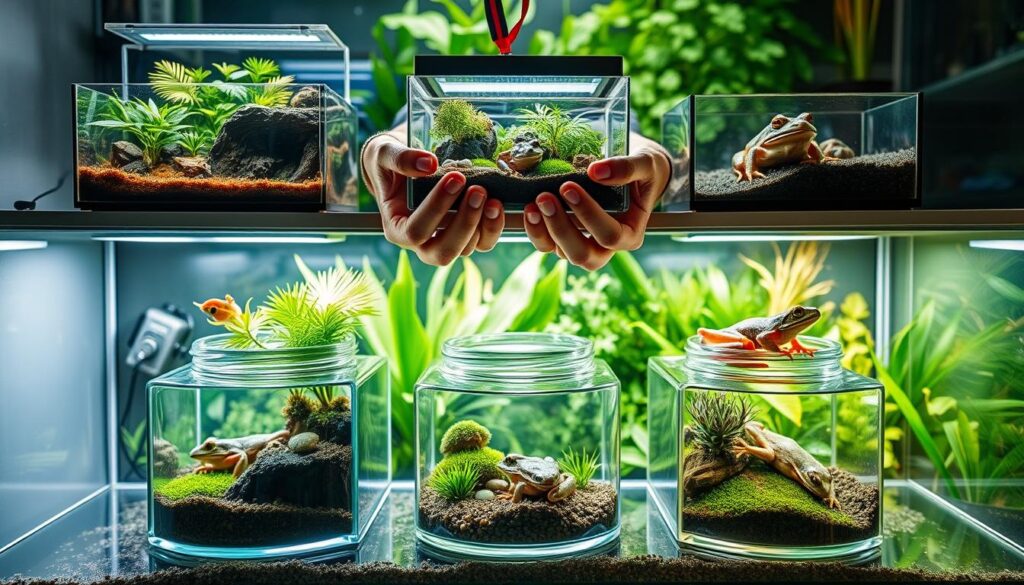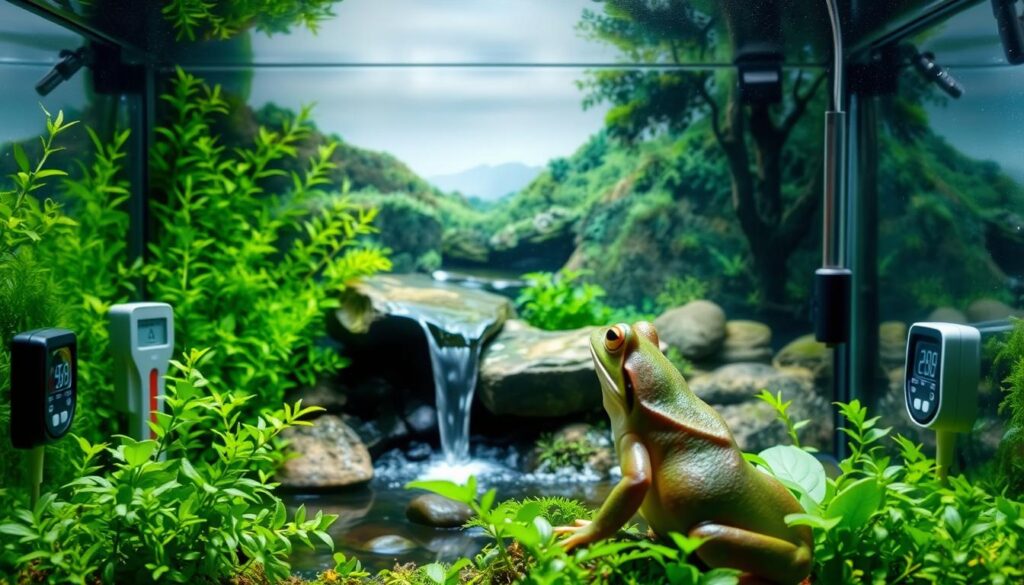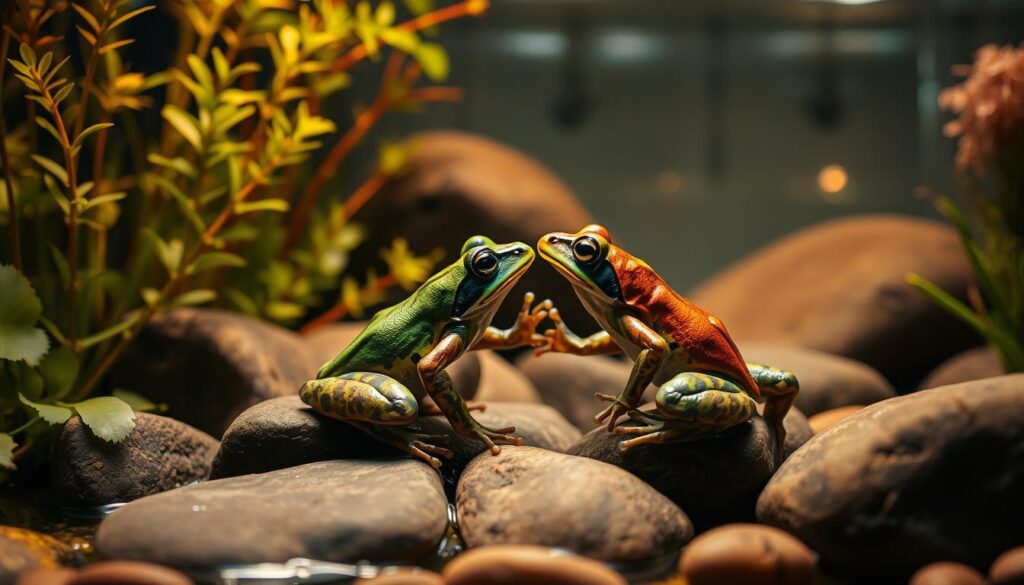Did you know there are over 7,000 species of frogs worldwide? Each one has unique habitat needs. Creating the right environment is crucial for their health and breeding success.
Experts like Dr. Laurie Hess and Dustin Smith emphasize the importance of mimicking natural ecosystems. A well-designed enclosure ensures frogs thrive and reproduce.
Key components include the right tank, substrate, and water systems. Lighting and maintenance also play a vital role. Whether your frog is arboreal or terrestrial, the setup must match its natural behavior.
Bioactive environments can enhance the habitat. They replicate natural ecosystems, promoting healthier frogs and better breeding outcomes. Proper planning leads to a thriving pet and successful reproduction.
Key Takeaways
- Over 7,000 frog species have unique habitat needs.
- Proper tank setup is vital for health and breeding success.
- Experts recommend mimicking natural ecosystems.
- Essential components include tank type, substrate, and water systems.
- Bioactive environments enhance frog well-being.
Understanding the Basics of Frog Tank Setup
Creating the perfect home for your frog starts with understanding their unique needs. Each frog species has specific requirements for their environment, and getting it right ensures they stay healthy and happy.
Why Proper Tank Setup is Crucial for Frogs
Frogs are sensitive creatures, and their translucent skin often reflects their health. An improper setup can lead to stress, disease, or even shorter life spans. Mimicking their natural habitat is the best way to keep them thriving.
Humidity and ventilation are critical factors. Glass enclosures, like the expert-recommended Exo Terra terrariums, are excellent for retaining moisture. Proper airflow also prevents escape attempts and ensures a comfortable environment.
Different Types of Frog Enclosures: Terrariums, Vivariums, and Paludariums
Choosing the right type of enclosure depends on your frog’s natural behavior. Terrariums are ideal for land-dwelling species, with 75% land space and live plants. Vivariums, on the other hand, are bioactive setups that include living organisms, perfect for species like dart frogs.
Paludariums combine land and water features, making them suitable for aquatic or semi-aquatic species. For example, aquatic frogs thrive in paludariums with 50% water and 50% land. Understanding these differences ensures your frog’s habitat meets their needs.
For more detailed guidance on creating the ideal tank set, check out this helpful resource.
Choosing the Right Tank for Your Frog Species
Selecting the right enclosure is the foundation of a healthy frog habitat. The type of tank you choose directly impacts your frog’s well-being and behavior. Whether you’re caring for arboreal tree frogs or terrestrial species, understanding their natural needs is key.

Vertical vs. Horizontal Tanks: What’s Best for Your Frog?
Arboreal species, like red-eyed tree frogs, thrive in vertical tanks. These enclosures provide ample climbing room, mimicking their natural habitat. A standard 18″x18″x24″ tank is ideal for these active climbers.
Terrestrial species, such as Pacman frogs, need horizontal tanks. These provide more ground area for movement and burrowing. A 20-gallon tank is recommended for terrestrial frogs to ensure they have enough space.
Size Considerations for a Healthy Frog Environment
Tank size is crucial for your frog’s health. A general rule is 10 gallons per 2 inches of frog length. For example, Pacman frogs require at least 10 gallons per frog to prevent aggression and stress.
Overcrowding can lead to territorial disputes and health issues. Always consider growth transitions, especially for juvenile frogs. Providing a spacious area ensures they thrive as they mature.
“A choice-rich environment encourages natural behaviors and reduces stress,” says a curator from the NC Zoo.
Materials also matter. Glass tanks retain humidity well, while acrylic offers durability. Choose the way that best suits your frog’s needs and your maintenance preferences.
Essential Components for a Frog Breeding Tank
The right components can make or break your frog’s environment. From the substrate to hideouts, every detail plays a crucial role in their health and happiness.

Substrate: Creating a Natural Floor for Your Frog
A proper substrate mimics the natural soil of a frog’s habitat. A three-layer system works best: Hydroton clay balls at the bottom for drainage, a screen to separate layers, and an organic top layer like coconut fiber or sphagnum moss.
Bioactive substrates are a great choice. They include springtails, which help manage waste and maintain a clean environment. For tropical species, Zoo Med Eco Earth is highly recommended. Disposable substrates, while easier to replace monthly, lack the long-term benefits of bioactive options.
Hideouts and Retreats: Providing Safe Spaces for Frogs
Hideouts are an essential part of frog care. Cork bark, coconut huts, and PVC pipes make excellent retreats. Place them in both cool and warm zones to give your frog options.
Sterilized driftwood and bamboo cholla are safe materials. Avoid sharp-edged decor to prevent skin abrasions. Species like tomato frogs also need burrowing-friendly setups to feel secure.
“A choice-rich environment encourages natural behaviors and reduces stress,” says a curator from the NC Zoo.
By focusing on these components, you create a thriving space for your frog to live and breed successfully.
Water Accessories: Ensuring Clean and Safe Water
Clean and safe water is essential for a frog’s health and breeding success. Frogs absorb water through their skin, making quality a top priority. Poor water conditions can lead to stress, illness, or even death.

Dechlorinating Water: Why It’s Important and How to Do It
Chlorine in tap water is toxic to frogs. It can damage their skin and nervous system. Using a water conditioner like Seachem Prime or API Tap Water Conditioner removes chlorine and chloramines, making water safe.
Always test water parameters. The ideal pH range is 6.5 to 7.5, with 0 ammonia. Signs of poor water quality include cloudiness, biofilm, or a foul odor. Regular testing ensures a healthy environment.
Water Dishes and Misting Systems: Keeping Frogs Hydrated
Frogs hydrate by soaking or absorbing water through their skin. Provide a shallow dish with a minimum depth of 1 inch. Use non-porous materials to prevent bacteria buildup.
Misting systems like MistKing Starter automate hydration. They maintain 85% humidity with 3-5 misting sessions per day. Hand sprayers are an alternative but require more time and effort.
“Proper hydration is key to a frog’s health. Automated systems ensure consistency,” says a reptile care expert.
For wild-caught frogs, acclimate them slowly to pond water. This reduces stress and helps them adjust to their new environment.
Lighting and Heating: Mimicking Natural Conditions
Proper lighting and heating are vital for frog health and breeding success. Frogs rely on these elements to maintain their natural behaviors and overall well-being. Mimicking their native environment ensures they thrive in captivity.

UVB Lighting: Supporting Frog Health and Vitamin D Production
UVB lighting is essential for frogs, especially diurnal species. It helps them produce Vitamin D3, which is crucial for calcium absorption. Without it, frogs can develop metabolic bone disease, a serious health issue.
Arcadia ShadeDweller Pro UVB kits are ideal for nocturnal species. They provide the right amount of UVB without overexposure. For diurnal frogs, T5 or T8 fixtures offer better coverage and efficiency.
Maintaining a 12-hour photoperiod with timers ensures consistency. This mimics natural day and night cycles, promoting healthy activity patterns. Proper care of lighting systems is a top priority for frog owners.
Heating Options: Maintaining the Right Temperature for Your Frog
Frogs need specific temperature gradients to stay healthy. Daytime temperatures should range between 72-80°F, while nighttime can drop to 65-75°F. This mimics their natural habitat and supports their metabolism.
Ceramic Heat Emitters (CHE) are a safe option for heating. Unlike under-tank heaters, they don’t risk overheating the skin. Zoo Med ReptiTemp rheostats help regulate heat levels, ensuring a stable environment.
Digital thermometers are essential for monitoring. Place them in different zones to check for proper gradients. Overheating can be dangerous, so always prioritize safety in your setup.
“A stable temperature and lighting system are the foundation of a healthy frog habitat,” says a reptile care expert.
For nocturnal observation, moonlit LED options provide soft lighting. They allow you to monitor your frog without disrupting their natural behavior. These small details make a big difference in their overall care.
Setting Up Your Frog Breeding Tank: Step-by-Step Guide
Creating a thriving habitat for frogs requires careful planning and attention to detail. Each step ensures their health and breeding success. Follow this guide to build a safe and comfortable home for your frogs.

Step 1: Cleaning and Preparing Your Tank
Start by disinfecting the tank to remove harmful bacteria. Use a 10% bleach solution mixed with dechlorinated water. Soak the enclosure for 15 minutes, then rinse it thoroughly three times. Treat the tank with a water conditioner like Seachem Prime to neutralize any remaining chemicals.
Allow the tank to cure for 48 hours before adding any components. This stabilization period ensures a safe environment for your frogs. Proper cleaning prevents health issues and prepares the tank for the next steps.
Step 2: Adding Substrate and Non-Electric Accessories
Layer the tank with a 2-inch drainage layer of Hydroton clay balls. Place a mesh screen on top to separate it from the substrate. Add a 3-inch bioactive layer of coconut fiber or sphagnum moss. This setup mimics their natural habitat and promotes healthy bacteria growth.
Arrange hardscape elements like slate ledges and floating platforms. These provide climbing and resting areas. Use sterilized driftwood or bamboo cholla for safe hideouts. Avoid sharp-edged decor to prevent injuries.
Step 3: Installing Water, Lighting, and Heating Systems
Install a sponge filter for low-flow water systems. This ensures clean water without strong currents. Use API Quick Start to cycle the tank and establish beneficial bacteria. Monitor water parameters daily to maintain optimal conditions.
Set up UVB lighting for diurnal species and a ceramic heat emitter for stable temperatures. Maintain a 12-hour photoperiod with timers. For nocturnal observation, use moonlit LED lights. These systems replicate natural conditions and support frog health.
“Proper setup ensures frogs thrive and breed successfully. Every detail matters,” says a reptile care expert.
For more tips on maintaining a healthy environment, check out this helpful resource.
Monitoring and Maintaining Your Frog Tank
Keeping your frog’s habitat in top shape requires consistent care and attention. Regular maintenance ensures a clean and healthy environment, which is essential for their well-being. By following a structured routine, you can prevent common issues and keep your frogs thriving.

Daily and Weekly Maintenance Tasks
Daily tasks are simple but crucial. Remove feces and uneaten food to prevent bacteria buildup. Refresh water dishes with dechlorinated water to ensure hydration. Misting the enclosure maintains humidity levels, which is vital for your frog’s skin health.
Weekly tasks include scrubbing the glass to remove algae and trimming plants to keep the habitat tidy. These steps help maintain a clean and visually appealing environment. Consistency is key to preventing long-term issues.
How to Clean the Tank and Replace Substrate
Monthly maintenance involves a full substrate replacement. Over time, the substrate can break down, leading to a sour odor. Remove the old substrate and clean the tank thoroughly. Use a 10% bleach solution, rinse well, and let it air dry before adding fresh substrate.
For partial water changes, replace 25% of the water weekly. This helps maintain optimal water quality without disrupting the tank’s ecosystem. Use a filter to keep the water clean, and clean the impeller monthly to ensure it functions efficiently.
| Task | Frequency | Details |
|---|---|---|
| Remove feces and uneaten food | Daily | Prevents bacteria buildup |
| Refresh water dishes | Daily | Use dechlorinated water |
| Mist the enclosure | Daily | Maintains humidity levels |
| Scrub glass and trim plants | Weekly | Keeps the habitat clean |
| Replace substrate | Monthly | Prevents odor and breakdown |
| Partial water changes | Weekly | 25% of water replaced |
“A well-maintained habitat is the foundation of a healthy frog. Consistency in care ensures they thrive,” says a reptile care expert.
By following these steps, you can create a safe and comfortable environment for your frogs. Regular maintenance not only supports their health but also enhances their quality of life.
Common Mistakes to Avoid When Setting Up a Frog Tank
Avoiding common pitfalls is essential for creating a healthy environment for your frogs. Even small errors can lead to serious health issues, affecting their well-being and breeding success. By understanding these mistakes, you can ensure your frogs thrive in their habitat.

Overcrowding the Tank: Why Space Matters
Overcrowding is a major issue that can harm your frogs. It increases the risk of chytrid fungus by 200%, a deadly disease for many species. Signs of overcrowding include aggression, weight loss, and excessive hiding.
Provide enough space for each frog to move freely. A general rule is 10 gallons per 2 inches of frog length. This prevents stress and territorial disputes, ensuring a peaceful environment.
- Avoid adding too many frogs to one tank.
- Monitor behavior for signs of stress or aggression.
- Separate frogs if conflicts arise.
Neglecting Water Quality: The Risks of Poor Maintenance
Water quality is critical for frog health. Poor maintenance can lead to 68% of health issues, including bloat disease and skin infections. Tap water often contains heavy metals, which can cause edema and other problems.
Always use a water conditioner to remove chlorine and chloramines. Test the water regularly to ensure it meets the ideal pH range of 6.5 to 7.5. Dirty dishes and stagnant water can also lead to bacterial growth, so clean them frequently.
“Proper hydration and clean water are the foundation of a healthy frog habitat,” says a reptile care expert.
- Replace 25% of the water weekly.
- Use a sponge filter to keep the water clean.
- Avoid distilled water, as it lacks essential minerals.
By addressing these common mistakes, you can create a safe and thriving environment for your frogs. Regular monitoring and proper care ensure they stay healthy and happy.
Expert Tips for a Successful Frog Breeding Experience
Breeding frogs successfully requires careful planning and attention to detail. Each frog species has unique needs, and understanding these is the key to creating a thriving environment. Whether you’re a beginner or an experienced breeder, these tips will help you achieve the best results.

Choosing the Right Frog Species for Breeding
Not all frogs are the same when it comes to breeding. Beginners may find success with White’s tree frogs, which mature in about three years. These hardy frog species are less demanding and adapt well to captivity.
For advanced breeders, Amazon milk frogs offer a challenge with their complex mating rituals. Dart frogs are another popular choice, but they require precise conditions to lay eggs. African dwarf frogs, on the other hand, are easier to breed and are ideal for those new to the hobby.
- Compare breeding difficulty: Dart frogs vs. African dwarf frogs.
- Highlight parental care variations: Gastric brooding frogs.
- Provide USDA breeding permit requirements for certain species.
Creating a Stress-Free Environment for Frogs
A stress-free home is essential for frogs to thrive and reproduce. Start by simulating natural conditions. Monsoon simulation techniques, such as misting and temperature drops, can trigger breeding behaviors.
Use digital hygrometers like the Exo Terra TerraTemp to monitor humidity levels. Java moss and spawning mops are excellent choices for egg-laying media. For tadpole rearing, Hikari First Bites provides the necessary nutrients for healthy growth.
| Tool | Purpose |
|---|---|
| Digital Hygrometer | Monitor humidity levels |
| Java Moss | Egg-laying media |
| Hikari First Bites | Tadpole feeding |
“A stress-free environment encourages natural behaviors and increases breeding success,” says a reptile care expert.
By focusing on these things, you can create a comfortable and safe space for your frogs. This ensures they live a healthy life and reproduce successfully.
Conclusion: Your Path to a Thriving Frog Breeding Tank
The key to successful frog care lies in attention to detail. By focusing on species-specific design, maintaining clean water, and regular monitoring, you create a healthy environment for your frogs. Start with a basic setup and gradually upgrade to bioactive systems for long-term success.
Joining herpetological societies can provide valuable insights and support. Keep a breeding journal to track progress and plan for genetic diversity. Patience is essential when establishing microhabitats, as it takes time for frogs to adapt.
Finally, schedule vet checks for first clutches to ensure their health. Captive breeding programs also contribute to conservation efforts, making this a rewarding way to care for these fascinating creatures. With dedication and proper care, your tank will become a thriving home for your frogs.
FAQ
Why is proper tank setup important for frogs?
What types of enclosures work best for frogs?
Should I choose a vertical or horizontal tank for my frog?
How big should a frog tank be?
What substrate is best for a frog tank?
Why is dechlorinating water important for frogs?
Do frogs need UVB lighting?
How often should I clean the frog tank?
What are common mistakes to avoid in frog tank setup?
How can I create a stress-free environment for my frogs?

I’m Lena Adams—a product of an unconventional upbringing in the African wilderness. My father, a daring explorer of African wildlife, sparked my fascination with reptiles, a passion that intertwined with the tragic loss of my mother during an expedition, leaving an indelible mark on my life. Driven to understand the creatures that captivated my parents, I embarked on my journey, sharing insights about reptiles, frogs, and lizards on my website. Through my explorations and conservation efforts, I honour my family’s legacy while seeking connections—to the creatures, nature, and the mother whose presence I yearn to understand.
